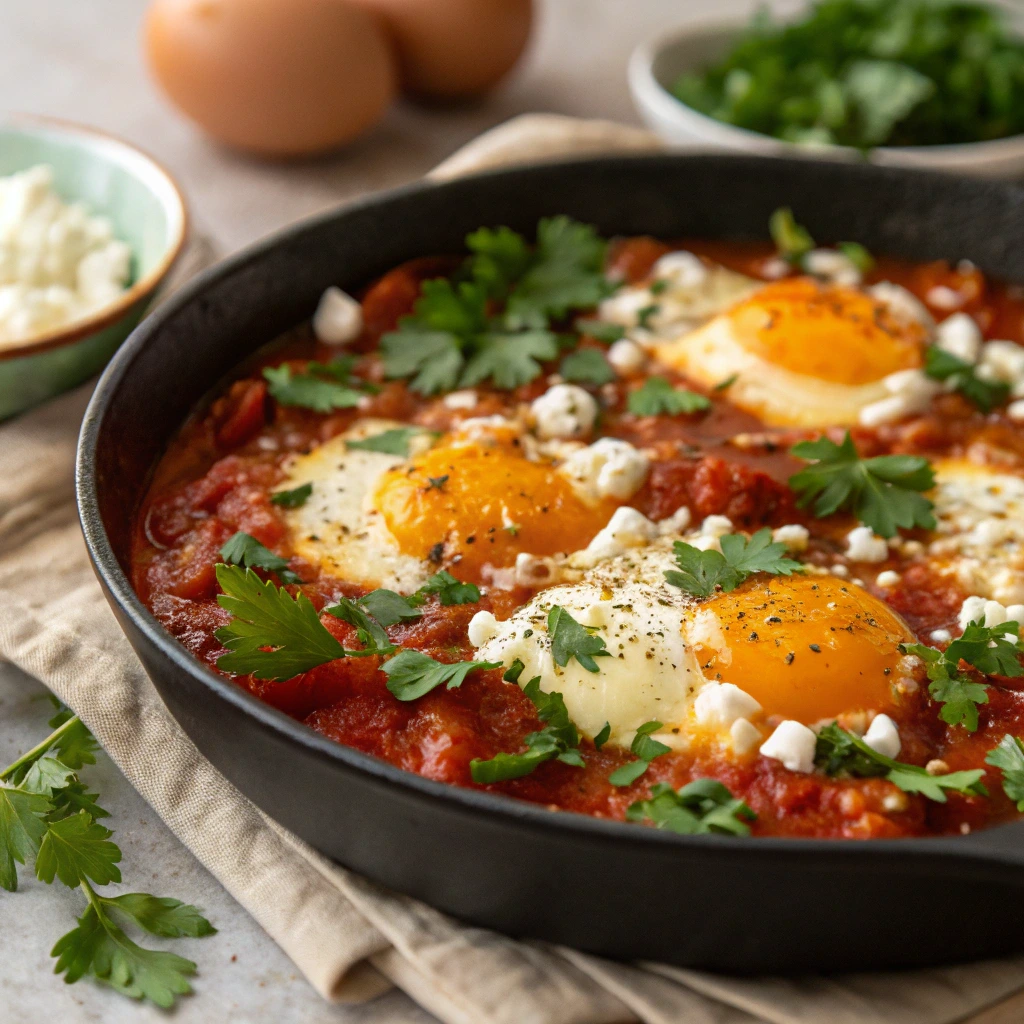
Introduction
Imagine waking up on a lazy Sunday morning, the aroma of sizzling spices and fresh tomatoes wafting through your kitchen. You’re about to create something truly special—a dish that’s as comforting as it is flavorful. Welcome to the world of shakshuka, a Middle Eastern breakfast sensation that has taken kitchens around the globe by storm. In this comprehensive guide, we’ll walk you step-by-step through how to make perfect shakshuka at home. Whether you’re a seasoned cook or just starting out, this recipe will inspire confidence and delight your taste buds.
Shakshuka isn’t just any breakfast dish; it’s a celebration of vibrant flavors and rich cultural heritage. Originating in North Africa and the Middle East, this hearty tomato-based egg dish has become a global favorite for its simplicity, versatility, and sheer deliciousness. By the end of this article, you will have all the tools and knowledge needed to whip up a bowl of shakshuka that rivals even the best restaurant versions.
Let’s dive in!
What Is Shakshuka? Understanding the Dish
Origins of Shakshuka
Shakshuka traces its roots back to the bustling markets of North Africa and the Middle East, particularly Morocco, and Tunisia. For centuries, it was enjoyed as a simple yet satisfying breakfast among families who valued wholesome, nutrient-dense meals. Today, it stands as a symbol of comfort and community, bringing people together over shared tables and warm conversations. Its name itself means “mixed” in Arabic, reflecting the harmonious blend of ingredients that define this iconic dish.
Did you know? Shakshuka gained international recognition thanks to Israeli cuisine’s rise in popularity, earning praise from chefs and food enthusiasts worldwide.
Key Ingredients in Shakshuka
To craft an authentic shakshuka, here are the essential building blocks:
- Tomatoes : The star of the show, providing sweetness and acidity.
- Eggs : Poached gently in the spiced tomato sauce for creamy perfection.
- Bell Peppers & Onions : Adding crunch and depth.
- Garlic : Infusing the sauce with aromatic warmth.
- Cumin & Paprika : Spices that elevate the dish with earthy and smoky notes.
- Olive Oil : A staple ingredient for both flavor and health benefits.
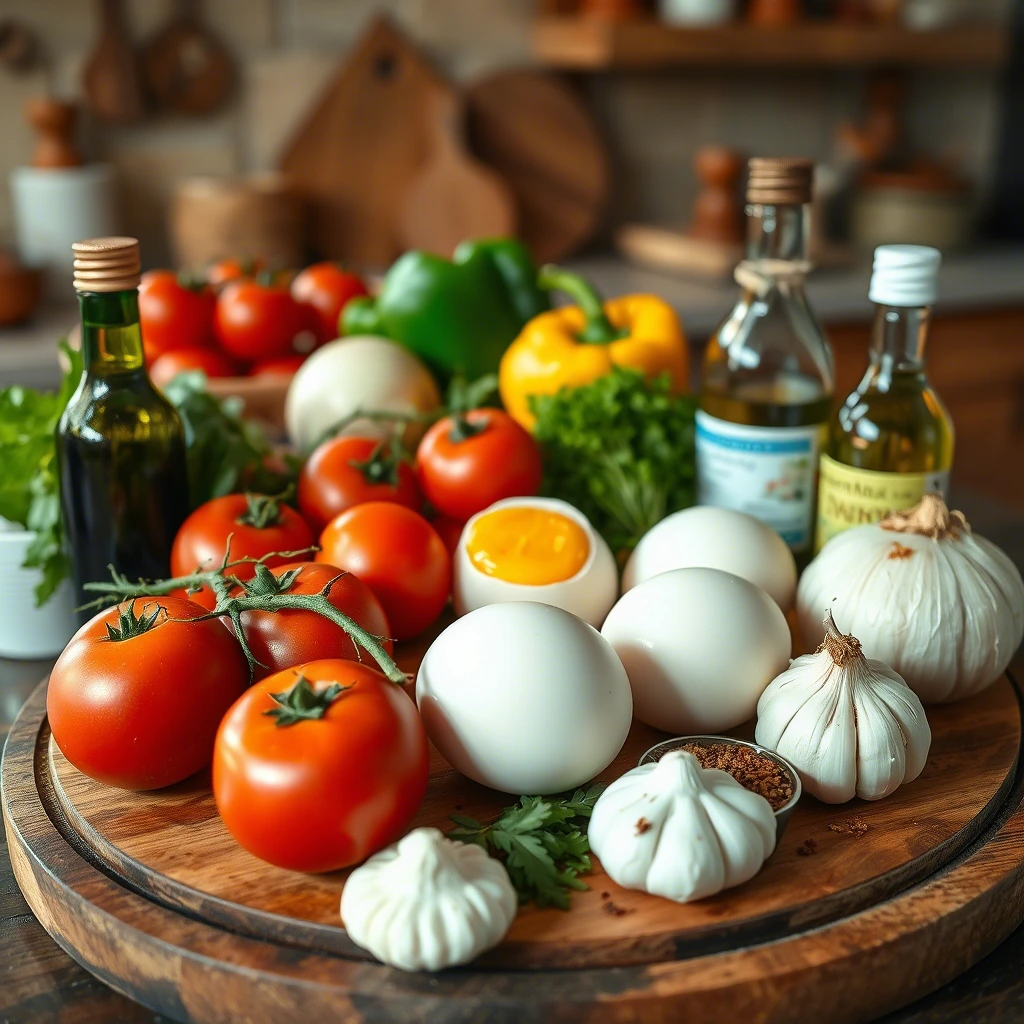
Optional extras include feta cheese, chickpeas, spinach, or fresh herbs—depending on your preference.
Why Shakshuka Is So Popular
Here’s why shakshuka continues to captivate hearts (and stomachs):
- Nutritious : Packed with vitamins, protein, and antioxidants.
- Versatile : Enjoy it for breakfast, brunch, lunch—or even dinner!
- Customizable : Tailor it to suit dietary needs like veganism or gluten-free lifestyles.
Common Questions About Shakshuka
Before we move forward, let’s address some frequently asked questions:
- Can I make shakshuka vegan? Absolutely! Simply omit the eggs and serve with extra veggies or tofu.
- Is shakshuka spicy by default? Not necessarily. Adjust heat levels using mild or hot paprika.
- Does shakshuka pair well with sides? Yes! Think pita bread, salads, or roasted potatoes.
Gathering Your Ingredients and Tools
Essential Ingredients for Shakshuka
For a classic version, gather these key players:
| Ingredient | Quantity |
|---|---|
| Tomatoes | 4 large, chopped |
| Eggs | 6 |
| Bell peppers | 2, diced |
| Onion | 1, finely chopped |
| Garlic cloves | 3, minced |
| Olive oil | 2 tbsp |
| Ground cumin | 1 tsp |
| Smoked paprika | 1 tsp |
| Salt & pepper | To taste |
Feel free to tweak quantities based on serving size.
Equipment You’ll Need
No fancy gadgets required here—just basic kitchen essentials:
- Skillet or frying pan
- Wooden spoon or spatula
- Measuring cups/spoons
- Cutting board and knife
Preparing Your Workspace
A tidy workspace makes cooking smoother:
- Wash and chop all vegetables ahead of time.
- Measure spices and oils for easy access.
- Ensure your skillet is clean and ready to go.
Substitutions for Common Ingredients
If certain items aren’t available, don’t worry! Here are alternatives:
- Replace cumin with coriander or turmeric.
- Swap smoked paprika for chili powder for added kick.
- Use silken tofu instead of eggs for a vegan option.
Step-by-Step Instructions to Make Shakshuka
1: Prepare the Base Sauce
Begin by heating olive oil in your skillet over medium heat. Add onions and sauté until translucent, then toss in garlic and bell peppers. Cook for another 5 minutes before adding chopped tomatoes, cumin, paprika, salt, and pepper. Stir well and let the mixture simmer for 10–15 minutes, allowing flavors to meld.
2: Crack Eggs into the Sauce
Using the back of a spoon, create small wells in the simmering sauce. Gently crack one egg into each well, being careful not to break the yolks. Repeat until all eggs are placed.
3: Cook Until Done
Cover the skillet and reduce heat to low. Let the eggs poach in the sauce for 8–10 minutes, depending on desired doneness. Peek occasionally to ensure they’re cooking evenly.
4: Garnish and Serve
Sprinkle fresh parsley or cilantro over the top. Crumble feta cheese if desired and drizzle with extra virgin olive oil. Serve immediately with warm pita bread or crusty baguette.
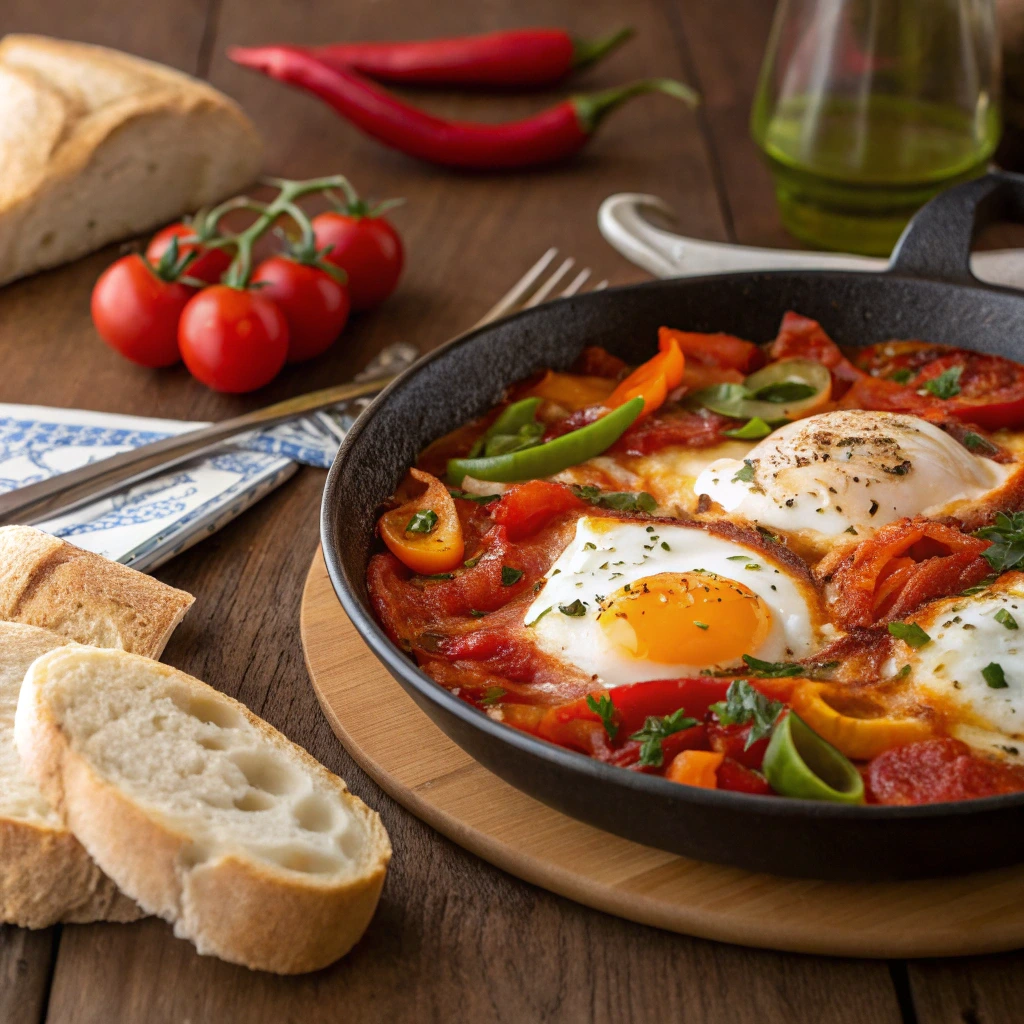
Tips for Perfecting Your Shakshuka
Achieving the Right Consistency
The consistency of your shakshuka sauce plays a crucial role in its overall appeal. Here’s how to get it just right:
- Simmer patiently : Allow the tomato mixture to cook slowly over medium-low heat. This helps evaporate excess water and intensifies flavors.
- Adjust liquid levels : If the sauce seems too thick, add a tablespoon or two of water to loosen it. Conversely, if it’s too thin, let it simmer uncovered for a few more minutes.
- Blend partially (optional) : For a smoother texture, blend half of the cooked tomato mixture before returning it to the skillet. This creates a velvety base while retaining some chunky bits.
Balancing Flavors
Flavor balance is what separates an ordinary dish from an extraordinary one. Follow these tips:
- Layer spices strategically : Start with cumin and paprika, then taste and adjust as needed. Consider adding a pinch of cinnamon or nutmeg for subtle sweetness.
- Balance acidity : Tomatoes can sometimes be too tangy. Counteract this by adding a teaspoon of sugar.
- Salt wisely : Under-salting ruins even the best recipes. Season generously but taste frequently to avoid oversalting.
Customizing Your Recipe
Shakshuka is incredibly adaptable. Here are some ideas to personalize your dish:
- Add protein : Incorporate chickpeas, black beans, or lentils for extra heartiness.
- Boost greens : Stir in chopped kale, Swiss chard, or spinach during the last few minutes of cooking.
- Experiment with cheeses : While feta is classic, try ricotta, goat cheese, or even grated Parmesan for variety.
Avoiding Common Mistakes
Even experienced cooks can stumble when making shakshuka. Steer clear of these pitfalls:
- Overcrowding the pan : Too many eggs in one skillet can lead to uneven cooking. Use a larger pan or cook in batches.
- Neglecting mise en place : Preparing ingredients beforehand ensures smooth execution and reduces stress.
- Using inferior produce : Fresh, ripe tomatoes make all the difference. Opt for seasonal or canned San Marzano tomatoes if fresh ones aren’t available..
The Cultural Significance of Shakshuka
Shakshuka isn’t just a dish—it’s a reflection of history, culture, and community. Originating in North Africa and the Middle East, this beloved breakfast staple has deep roots in regions like Tunisia, Morocco, and Israel. Its name, which means “mixed” in Arabic, symbolizes the harmonious blend of ingredients and cultures that come together in one pot.
To learn more about the fascinating origins and global journey of shakshuka, check out this insightful article from Saveur (a trusted culinary resource). Understanding its cultural significance adds another layer of appreciation when preparing this delicious dish at home.. Let’s delve into its historical and social importance:
A Dish of Unity
Shakshuka transcends borders, bringing together diverse cultures under one shared love for food. In Israel, it’s a staple breakfast item enjoyed by people of all backgrounds. Similarly, in North Africa, variations of the dish reflect local traditions and available ingredients.
Symbolism in Ingredients
Each ingredient in shakshuka holds symbolic meaning:
- Tomatoes : Represent vitality and nourishment.
- Eggs : Symbolize new beginnings and fertility.
- Spices : Embodiment of warmth and hospitality.
Modern-Day Popularity
Today, shakshuka has become a symbol of global culinary fusion. Chefs worldwide experiment with innovative takes, incorporating local ingredients and techniques. Its rise in popularity underscores the universal appeal of comfort foods that celebrate simplicity and community.
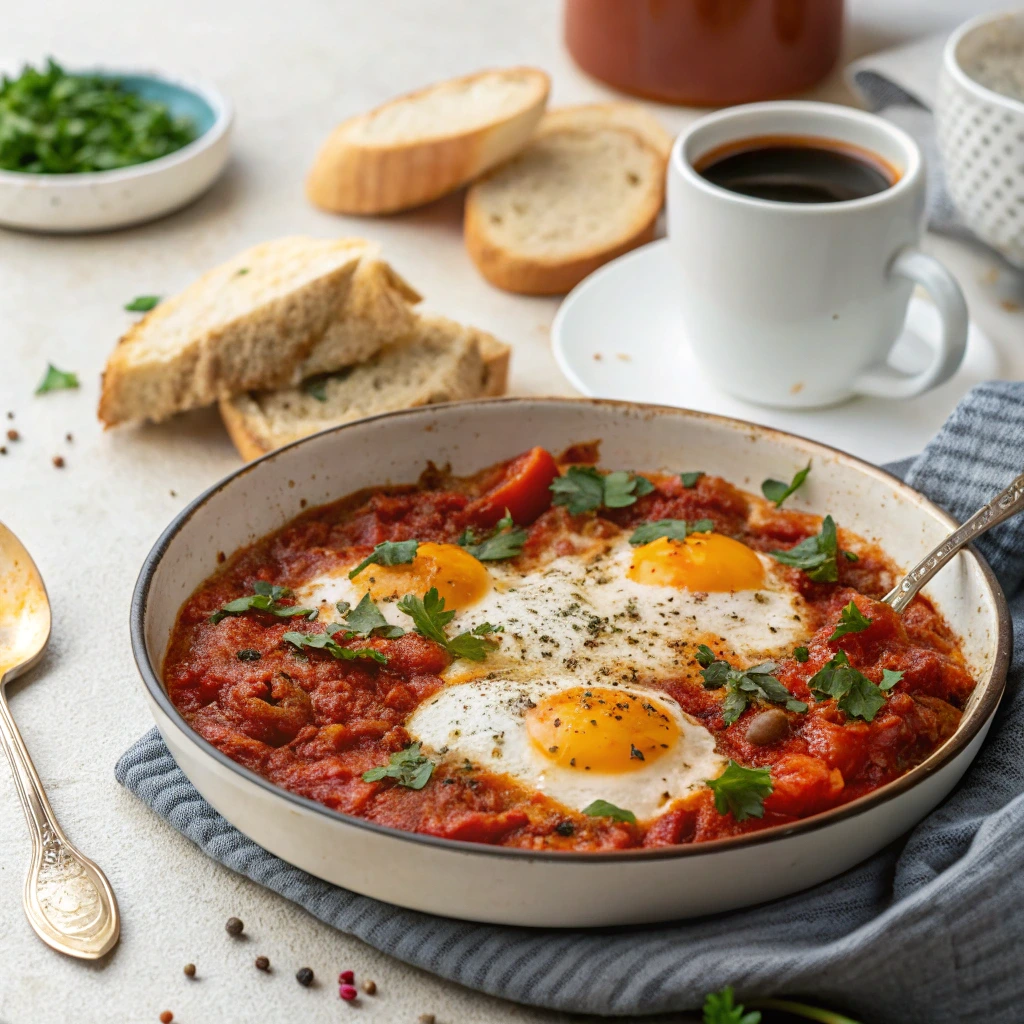
Troubleshooting Common Issues
Even with careful preparation, challenges may arise. Here’s how to address common problems when making shakshuka:
Eggs Breaking While Poaching
If your eggs break while poaching, try these solutions:
- Create wells carefully using the back of a spoon.
- Crack eggs into a small bowl first, then gently slide them into the sauce.
- Avoid overcrowding the skillet to give each egg enough space.
Sauce Becoming Too Watery
Excess liquid dilutes the flavor of your shakshuka. To fix this:
- Simmer uncovered for longer periods to reduce water content.
- Blend part of the sauce to thicken it naturally.
- Add a tablespoon of tomato paste for extra body.
Overpowering Spices
Too much spice can overshadow other flavors. Balance it out by:
- Diluting the sauce with water or stock.
- Adding more tomatoes or a splash of cream for richness.
- Serving with neutral sides like plain yogurt or bread to cut through intensity.
Serving Suggestions and Pairings
Best Sides for Shakshuka
Shakshuka pairs beautifully with a variety of accompaniments. Here are some top picks:
- Bread options :
- Warm pita bread
- Crusty baguette slices
- Naan or flatbread
- Vegetable sides :
- Roasted potatoes or sweet potatoes
- Grilled asparagus or zucchini
- Mixed salads with citrus dressing
- Protein additions :
- Smoked salmon or avocado for brunch flair
- Sausage or bacon for a heartier option
Drinks That Complement Shakshuka
The right beverage enhances the dining experience. Try these pairings:
- Coffee lovers :
- A strong espresso or cappuccino
- Cold brew coffee with almond milk
- Tea enthusiasts :
- Mint tea for freshness
- Chamomile tea for relaxation
- Juice alternatives :
- Freshly squeezed orange juice
- Pomegranate juice for a Middle Eastern twist
Occasions Where Shakshuka Shines
This versatile dish fits seamlessly into various settings:
- Weekend brunches : Serve alongside muffins, pastries, or fruit platters for a luxurious spread.
- Holiday gatherings : Offer it as part of a buffet-style breakfast or brunch menu.
- Quick weeknight meals : Simplify by omitting garnishes and serving with toast for convenience.
Storing and Reheating Leftovers
Leftover shakshuka can be enjoyed later with proper storage and reheating techniques:
Microwave method: Heat in short intervals, stirring occasionally to distribute warmth evenly.
Storage tips :
Transfer cooled shakshuka to an airtight container.
Refrigerate for up to 3–4 days or freeze for longer shelf life.
Reheating methods :
Skillet method: Gently reheat on low heat, adding a splash of water or broth to prevent drying.
Advanced Techniques for Mastering Shakshuka
For those looking to take their shakshuka game to the next level, here are some advanced techniques and ideas to refine your skills:
Roasting Vegetables for Deeper Flavor
Roasting vegetables before adding them to the skillet enhances their natural sweetness and adds complexity to the dish. Try this method:
- Preheat your oven to 400°F (200°C).
- Toss diced bell peppers, onions, and garlic with olive oil, salt, and pepper.
- Spread them evenly on a baking sheet and roast for 20–25 minutes, stirring halfway through.
- Once roasted, add these veggies to your tomato base for richer flavors.
Infusing Olive Oil with Spices
Infused olive oil elevates the aromatic profile of your shakshuka. Here’s how to make it:
- Heat olive oil in a small saucepan over low heat.
- Add whole spices like cumin seeds, coriander seeds, or dried chili flakes.
- Cook gently for 5–7 minutes, allowing the spices to release their oils.
- Strain the infused oil and use it as the base for sautéing onions and garlic.
Experimenting with International Variations
While traditional shakshuka remains timeless, exploring global twists can keep things exciting:
- Mexican-inspired shakshuka : Add chipotle powder, jalapeños, or black beans for a spicy kick.
- Indian fusion : Incorporate garam masala, turmeric, or yogurt-based garnishes.
- Mediterranean flair : Top with kalamata olives, sun-dried tomatoes, or fresh basil.
FAQ Section
Q: What is shakshuka?
A: Shakshuka is a traditional Middle Eastern dish consisting of poached eggs nestled in a spiced tomato sauce. It’s often served with bread for dipping and cherished for its simplicity and bold flavors.
Q: How long does shakshuka take to prepare?
A: From start to finish, shakshuka typically takes about 25–30 minutes to prepare. Prep work involves chopping vegetables, while cooking focuses on slow simmering and gentle poaching.
Q: Can I make shakshuka ahead of time?
A: Yes, you can prepare the tomato sauce in advance and store it in the refrigerator. When ready to serve, reheat the sauce and crack in fresh eggs for optimal results.
Q: Are there vegetarian or vegan versions of shakshuka?
A: Absolutely! Omit the eggs and replace them with tofu scrambles or chickpeas. You can also skip dairy-based garnishes like feta cheese and opt for nutritional yeast or avocado instead.
Q: Is shakshuka healthy?
A: Yes, shakshuka is considered a nutritious meal. Rich in vitamins from tomatoes, antioxidants from spices, and protein from eggs, it’s a balanced choice for breakfast or brunch.
Q: Can I use canned tomatoes instead of fresh ones?
A: Definitely! Canned tomatoes, especially San Marzano varieties, offer consistent flavor and texture. Drain and chop them before adding to the skillet.
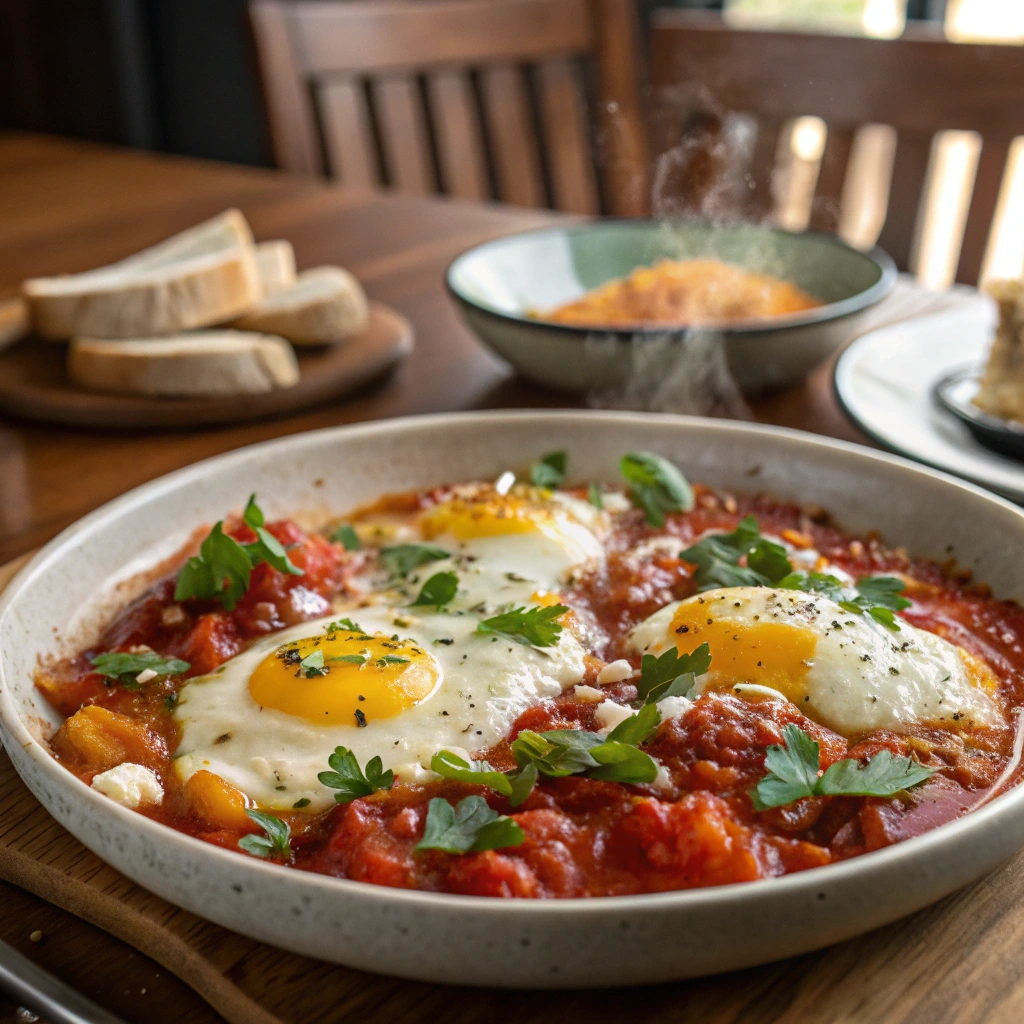
Conclusion
You’ve reached the end of our comprehensive guide to mastering shakshuka at home. By following the step-by-step instructions and incorporating personalized touches, you’re well on your way to creating a dish that reflects both tradition and creativity. Whether you’re hosting a weekend brunch or simply treating yourself to a comforting morning meal, shakshuka promises satisfaction every time.
Remember, cooking is an art form that evolves with practice. Don’t shy away from experimenting with new ingredients, techniques, or plating styles. Each attempt brings you closer to perfection—and don’t forget to enjoy the process!
We’d love to hear your thoughts. Share your favorite variations, ask questions, or post pictures of your creations in the comments below. Together, let’s celebrate the joy of cooking and the magic of shakshuka!. Happy cooking!
Call-to-Action
Ready to elevate your culinary skills? Start with shakshuka today and discover why this dish has captured hearts worldwide. Dive into the recipe, explore our tips, and join the conversation. Happy cooking, and may your kitchen always be filled with delicious aromas and joyful moments!
